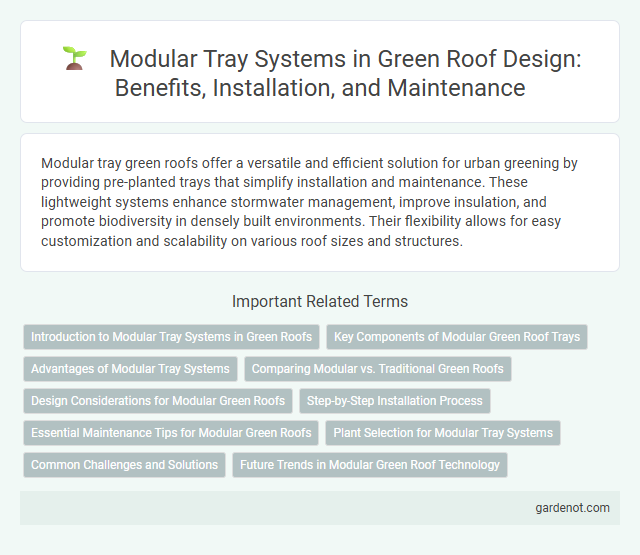Modular tray green roofs offer a versatile and efficient solution for urban greening by providing pre-planted trays that simplify installation and maintenance. These lightweight systems enhance stormwater management, improve insulation, and promote biodiversity in densely built environments. Their flexibility allows for easy customization and scalability on various roof sizes and structures.
Introduction to Modular Tray Systems in Green Roofs
Modular tray systems in green roofs consist of pre-planted trays designed for easy installation and maintenance, allowing for rapid green coverage and effective stormwater management. These trays offer flexibility for various roof sizes and shapes, promoting biodiversity and improving urban air quality. Their lightweight structure reduces load on buildings while enhancing insulation and energy efficiency.
Key Components of Modular Green Roof Trays
Modular green roof trays consist of layered components including a robust drainage layer, a water retention mat, and a lightweight growing medium tailored for optimal plant health. These trays often incorporate root barriers and filter fabrics to prevent soil migration and ensure structural integrity. Engineered for easy installation and maintenance, modular trays support diverse vegetation while enhancing stormwater management and thermal insulation.
Advantages of Modular Tray Systems
Modular tray roof systems offer rapid installation and easy maintenance due to their pre-grown vegetation panels, reducing labor costs and project timelines. These systems promote uniform plant growth and enhanced waterproofing, as trays contain integrated drainage and irrigation layers designed for optimal root health. Furthermore, modular trays increase flexibility in design and accessibility for repairs, making them ideal for both retrofit and new construction green roofs.
Comparing Modular vs. Traditional Green Roofs
Modular tray roofs offer faster installation and easier maintenance compared to traditional green roofs due to their pre-cultivated, self-contained plant trays. These systems provide enhanced flexibility for repairs and replacements without disturbing the entire roof structure, promoting cost efficiency over time. While traditional green roofs allow for extensive customization and deeper soil profiles, modular trays excel in urban environments requiring lightweight, scalable greening solutions.
Design Considerations for Modular Green Roofs
Modular tray green roofs require precise load-bearing analysis to support the combined weight of saturated substrates, vegetation, and structural components. Selecting lightweight, high-drainage growth media ensures efficient water retention and root aeration within confined trays, optimizing plant health and system longevity. Integration of modular trays must consider thermal insulation properties and ease of maintenance access to enhance building energy efficiency and long-term sustainability.
Step-by-Step Installation Process
Modular tray roofs simplify green roof installation by using pre-planted trays that fit together seamlessly, reducing onsite labor and allowing for rapid assembly. Each tray is equipped with drainage layers, growing media, and vegetation, which are laid out systematically according to a grid plan to ensure uniform coverage and proper water flow. Maintenance involves periodic inspection of tray alignment and irrigation systems to sustain optimal plant health and system longevity.
Essential Maintenance Tips for Modular Green Roofs
Regular inspection and cleaning of modular tray green roofs prevent debris buildup and root overgrowth, ensuring optimal drainage and plant health. Seasonal watering adjustments and nutrient management tailored to the specific vegetation enhance plant resilience and overall roof performance. Prompt replacement of damaged or diseased trays maintains the integrity and longevity of the modular green roofing system.
Plant Selection for Modular Tray Systems
Selecting drought-tolerant and low-maintenance plants such as Sedum, grasses, and native wildflowers is essential for modular tray green roof systems to ensure resilience and longevity. These plants thrive in shallow substrates and withstand extreme weather conditions while providing vital ecological benefits like stormwater retention and urban heat island mitigation. Incorporating a diverse mix of species enhances biodiversity and aesthetic appeal, optimizing the overall performance of modular tray green roofs.
Common Challenges and Solutions
Modular tray green roofs often face challenges such as limited root depth, uneven water distribution, and tray displacement due to wind or maintenance activities. Common solutions include selecting drought-tolerant, shallow-rooted plants, integrating efficient drainage systems to prevent waterlogging, and using secure interlocking tray designs to enhance stability. Regular inspection and maintenance help address potential issues early, ensuring optimal plant growth and roof performance.
Future Trends in Modular Green Roof Technology
Advancements in modular tray green roof technology are leading towards enhanced lightweight materials and integrated water retention systems, improving installation efficiency and environmental benefits. Smart sensor integration enables real-time monitoring of moisture and temperature, optimizing plant health and irrigation management. Future trends also emphasize sustainable, recyclable components and automated modular designs to reduce maintenance and extend roof lifespan.
Modular tray roof Infographic

 gardenot.com
gardenot.com